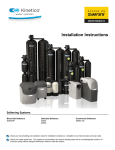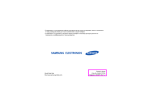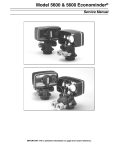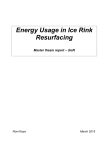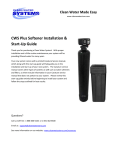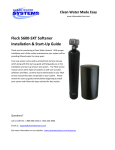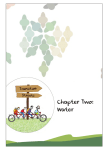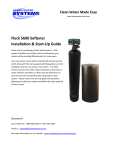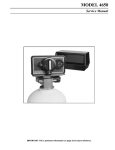Download Plumbline 2000 Series Metered Water Softeners Owners Manual
Transcript
Plumbline 2000 Series Metered Softeners Owners Manual “The Plumbline Product Line” Plumbline 2000 Series Metered Water Softeners Owners Manual 2011 Kinetico Incorporated www.plumblinewater.com Product No. 13786A Water Softener Models PS2000M PS2500M PS2700M PS2900M Plumbline Water Softeners Owners Manual Table of Contents How to Use Soft Water Plumbline Water Softeners Owners Manual Notes: ………………………………………………………………3 Product Line Overview …………………………………………………………………5 System Operation ………………………………………………………………………6 System Maintenance and Install Guidelines ………………………………………7 Startup……………………………………………………………………………………8 Troubleshooting ………………………………………………………………………9 Notes……………………………………………………………………………………11 Congratulations! We know you’ll love your clean, soft water and your new Plumbline Water Softener. You’ll soon wonder how you ever lived without it. Improving your water with a Plumbline Water Softener is just one way to enjoy better water in your home. A line of Plumbline Filters and Drinking Water Systems is also available to upgrade your water. Contact your plumbing contractor for more information about Plumbline products. ©2011 Kinetico Incorporated “Plumbline” and the Plumbline logo are trademarks of Kinetico Incorporated, Newbury, Ohio. Rev. 08/2011 Page 2 Product No. 13786A Rev. 08/2011 Page 11 Product No. 13786A Plumbline Water Softeners Owners Manual Problem Salt water in service line. Possible Causes A. Plugged injector system. B. Timer not cycling. C. Foreign material in brine valve. D. Foreign material in brine line flow control. Softener fails to draw brine. A. Draw line flow control is plugged. B. Injector is plugged. C. Injector screen plugged. D. Line pressure is too low. E. Internal control leak. Control cycles continuously. Drain flows continuously. Plumbline Water Softeners Owners Manual Solultions A. Clean injector and replace screen. B. Replace timer. C. Clean or replace brine valve. D. Clean brine line flow control. A. Clean drain line flow control. B. Clean or replace injectors. C. Replace screen. D. Increase line pressure (minimum 20 psi). E. Change seals, spacers and/or piston assembly. A. Faulty timer mechanism. A. Replace timer. A. Foreign material in control. A. Remove piston assembly and inspect bore, remove foreign material and check control in various regeneration positions. B. Replace seals and/or piston assembly. C, Replace seals and/or piston assembly. D. Replace timer. B. Internal control leak. C. Control valve jammed in brine or backwash position. D. Timer motor stopped or jammed. How to use soft water Now that your Plumbline water system is installed, you can enjoy all the benefits of having soft water. If you are not accustomed to soft water, here are some tips to follow to get the most benefit from your new system: Use pure soap products. Most leading brands of laundry soaps, household cleaners and shampoos contain large amounts of detergents. The harsh chemicals in these detergents are necessary when using hard water, but you can reduce your use or eliminate them altogether with soft water. We recommend you use pure soap products, clear liquid soaps without dyes and perfumes. If you continue to use your normal detergents, you should significantly reduce the amount used. Your local Plumbline contractor can provide you with more information and recommended detergent amounts. Use less soap and household cleaners. When using soap or cleaners with soft water, start by cutting the amount of soap you normally use in half. You may even find you can use as little as one-quarter the amount you were using before. Hardness minerals in water interfere with soap’s cleaning ability. Once they are removed, soap can do its job better. Even though you’ll use less soap, you’ll get more suds and cleaner results. It’s especially important to reduce the amount of laundry soap you use. Washing clothes in soft water not only means you’ll need less soap to get your clothes clean, but also that the soap you do use will rinse out completely. Washing in soft water makes your clothes look whiter and brighter, and they’ll last longer too. It is very important not to let your clothes sit in the washer after the cycle is complete. Detergent buildup can stain your clothing. Again, Plumbline recommends that you use clear, liquid soaps, without dyes or perfumes. After bathing in soft water, your skin should feel “slippery.” It’s not soap left on your skin. What you’re feeling is your own smooth skin without any leftover soap curd or residue. When you bathed in hard water, you were never able to rinse this residue off completely. The soap curd that left a ring in your bathtub was also left on your skin. But now that you have soft water, you’ll feel soft, smooth and clean. The same holds true for rinsing shampoo out of your hair. Reduce or eliminate the use of fabric softeners. Fabrics washed in hard water retain soap curd or residue making them “crackle” when removed from the dryer or stiff if air-dried. Fabric softeners are necessary with hard water to keep your clothing soft, but with soft water, you can reduce your use of fabric softeners or eliminate them altogether. Rev. 08/2011 Page 10 Product No. 13786A Rev. 08/2011 Page 3 Product No. 13786A Plumbline Water Softeners Owners Manual Plumbline Water Softeners Owners Manual Take special precautions with automatic dishwashers. Soft water, when combined with caustic phosphates in some dishwasher detergents and very high temperatures in the dry cycle, can etch dishes and glassware. To prevent this possibility: • use the “no heat” dry cycle on your dishwasher; • use the minimum amount of a good quality, low phosphate dishwasher detergent needed to clean your dishes. This may be as little as 20 percent of the amount recommended by the appliance manufacturer or on the dishwasher soap box; • wash good china and crystal by hand. Even though it takes three (3) hours for this center knob to complete one revolution, the regeneration cycle of your unit might be set only 1/2 of this time. In any event, conditioned water may be drawn after rinse water stops flowing from the water conditioner drain line. Plumbline Water Softener Troubleshooting Problem Possible Causes Softener fails to regenerate. A. Electrical service to unit has been interrupted. B. Timer is defective. C. Power failure. Special care for plants and fish. Depending on your water hardness level, amount of rainfall and how often you water, you could use soft water for outside watering, but why waste your soft water? Water your lawn, shrubs and outside plants from an outside hard water faucet, or put your Plumbline water system in by-pass before watering. See “By-pass” on page 7 for instructions on bypassing your system. Many houseplants can be watered with soft water, although some can be highly sensitive to the elevated level of sodium ions in soft water. You may prefer to water houseplants with hard water or water from a Plumbline reverse osmosis system. Fish accustomed to hard water may have trouble with an abrupt change to soft water. Make the change gradually over a period of seven to 14 days by blending hard and soft water until the tank contains 100 percent soft water. Once you begin using soft water, you should notice that your fish tank stays cleaner longer. Softener delivers hard water. A. By-pass valve is open. B. No salt in brine tank. C. Injectors or screen is plugged. D. Insufficient water flowing into brine tank. E. Hot water tank hardness. F. Leak at distributor tube. G. Internal valve leak. Unit uses too much salt. A. Improper salt setting. B. Excess water in brine tank. Loss of water pressure. A. Iron buildup in line to water softener. B. Iron buildup in water softener. C. Inlet control plugged due to foreign material loose from pipes by recent work done on plumbing system. Rev. 08/2011 Page 4 Product No. 13786A Solultions A. Assure permanent electrical service (check fuse, plug, pull chain or switch). B. Replace timer. C. Reset time of day. A. Close by-pass valve. B. Add salt to brine tank and maintain salt level above water level. C. Replace injectors and screen. D. Check brine tank fill time and clean brine line flow control if plugged. E. Repeated flushings of the hot water tank are required. F. Make sure distributor tube is not cracked. Check O-ring and tube pilot. G. Replace seals and spacers and/or piston. A. Check salt usage and salt setting. B. See excessive water in brine tank. A. Clean line to water filter. B. Clean control and add media cleaner to media bed. Increase frequency of regeneration. C. Remove piston and clean control. Loss of media through drain line. A. Air in water system. A. Assure that well system has proper air elimination control. Check for dry well condition. Iron in conditioned water. A. Fouled media bed. A. Check backwash, brine draw and brine tank fill, increase frequency of regeneration, increase backwash time. Excessive water in brine tank. A. Plugged drain line flow control. A. Clean flow control. Rev. 08/2011 Page 9 Product No. 13786A Plumbline Water Softeners Owners Manual Plumbline Water Softeners Owners Manual Product Line Overview Plumbline Set-up Procedures The Plumbline Water Softener is designed for applications with levels of hardness <100 gpg and levels of iron <10 ppm. Time Gear The Plumbline Water Softener is available in four (4) tank sizes and adjustable sequence times. These options allow the ideal configuration to be used for your application. Adjustable Regeneration Sequence Time: This valve allows for the time adjustment of each stage of regeneration which improves performance and reduces water consumption. Current Time Indicator Red Button White Dot Gallon Gear Gallon Wheel Set Knob 3. Programming Procedure Calculate the gallon capacity of the system, subtract the necessary reserve requirement and set the gallons available opposite the small white dot on the program wheel gear. The capacity (gallons) arrow denotes remaining gallons exclusive of fixed reserve. How To Set The Time Of Day Press and hold in the red button to disengage the drive gear. Turn the large gear until the actual time of day is at the time of day pointer. Release the red button to again engage the drive gear. How To Manually Regenerate Your Water Conditioner At Any Time: Turn the manual regeneration knob clockwise. This slight movement of the manual regeneration knob engages the program wheel and starts the regeneration program. The black center knob will make one revolution in the following three (3) hours (approximately) and stop in the position shown in Figure 1. Rev. 08/2011 Page 8 PS2000M PS2500M PS2700M PS2900M 13775A 13776A 13777A 13778A 8 gpm 9 gpm 10.3 gpm 13 gpm Power Requirements 120 VAC 60 Hz, 1 Amp 120 VAC 60 Hz, 1 Amp 120 VAC 60 Hz, 1 Amp 120 VAC 60 Hz, 1 Amp Backwash Flow Rate 1.5 gpm 2.0 gpm 2.4 gpm 4.0 gpm Capacity** 19,000 grains 27,300 grains 45,600 grains 75,000 grains Part Number ie: Calculated gallon capacity of system is 1000 gallons. Number of people using the system is 4. Use 75 gallons per person for a safe reserve capacity - 300 gallons reserve = 700 gallons available. This number should be set opposite the white dot on program wheel. 2. Specifications Product Figure 1 1. Metered with Time Delay: Metered systems are more efficient than timer configurations, as these units regenerate based on the actual water used. The integrated system meter tracks the volume of water processed and after the adjustable set-point has been reached, the regeneration process will start at 2:00 am. This allows for the process to take place when minimum to no water is being used in the house. Product No. 13786A Service Flow @ 15 psid* Brine Setting 10.5 lbs. 15 lbs. 22.5 lbs. 37.5 lbs. Salt Dose 15 lbs./ft³ 15 lbs./ft³ 15 lbs./ft³ 15 lbs./ft³ Tank Size 8” x 40” 10” x 40” 10” x 54” 13” x 54” 0.7 ft³ 1.0 ft³ 1.5 ft³ 2.5 ft³ Maximum Compensated*** Hardness 40 gpg 40 gpg 40 gpg 40 gpg Maximum Iron 2 mg/L 2 mg/L 2 mg/L 2 mg/L Volume of High Capacity Non-solvent Based Cation Resin * Service flow indicates typical household flow rates and is not an indication of system limitations. ** As tested to NSF/ANSI standard 44 by WQA under the Gold Seal Program, with the exception of PS2900M. ***Highest removal levels may not include certified brine settings. Please reference performance data sheet for details of certified and non-certified brine settings and efficiencies. Rev. 08/2011 Page 5 Product No. 13786A Plumbline Water Softeners Owners Manual Plumbline Water Softeners Owners Manual System Maintenance and Install Guidelines System Operation Your Plumbline Water Softener is designed to provide years of trouble-free operation. The following cycles soften your water and regenerate your system when necessary. Service: Hard water enters unit at the valve inlet and flows down through the resin in the media tank. Conditioned water enters the center tube through the bottom distributor, then flows up through the center tube, around the piston and out the outlet of the valve. Regeneration: When the valve is in regeneration, raw water is being passed to service until rapid rinse is complete. Backwash: Water enters unit at the valve inlet, flows through the piston, down the center tube, through the bottom distributor, and up through the resin, around the piston and out the drain line. Water is passed through the resin bed in the opposite direction of normal flow, which flushes suspended matter out of the resin tank. Backwashing also loosens the resin bed which becomes compacted during the softening (service) cycle. Brine/Slow Rinse: Hard water enters the unit at valve inlet, flows up into the injector housing and down through the nozzle and throat to draw brine from the brine tank. Brine flows down through resin and enters the center tube through the bottom distributor and out through the drain line. The resin beads are washed with the brine solution. Since the resin beads prefer calcium and magnesium ions, the slow rinse allows an overwhelming concentration of sodium ions to overpower and force the calcium and magnesium ions off of the resin beads and down the drain. Adding Salt Ensure that the salt level in the brine tank is always above the water line. Water Pressure Inlet water pressure range of 20-120 psi is required for regeneration valve to operate effectively. Electrical Facilities An uninterrupted 120 VAC / 60 Hz alternating current (A/C) supply is required. Please make sure voltage supply is compatible with unit before installation. Existing Plumbing Existing plumbing should be free from lime and iron buildup. Replace plumbing that has heavy lime and/or iron buildup. If plumbing is clogged with iron, install a separate iron filter unit ahead of the water softener. System By-pass Always provide for the installation of a by-pass valve if unit is not equipped with one. If valve is leaking, turn by-pass from Service to the By-pass position. Open By-pass Closed By-pass NOTE: If the valve continues to leak after turning the by-pass to By-pass position, shut off the main water line and call your local service technician (preferably the one who installed the system) IMMEDIATELY. Rapid Rinse: The resin bed is rinsed to remove excess brine solution from the tank, and the resin beads are then ready to produce soft water again. Hard water enters the unit at the valve inlet, flows down through the resin bed, then up through the center tube and out the drain line. CAUTION Do not exceed water pressure of 120 psi. Do not exceed water temperature of 110 ºF. Do not subject unit to freezing conditions. Brine Tank Refill: Hard water enters the unit at the valve inlet, flows up through the injector housing, and through the brine valve to refill the brine tank. Valve is now delivering soft water to the home. Water is refilling the brine tank to make a brine solution for the next regeneration. Sanitization After installation, or if water is not used for >30 days, sanitization of the system is recommended. Regenerate system, after regeneration, go through sanitization procedures. Mix 1 oz. of household, unscented bleach with 1 gallon of water in a bucket. Disconnect brine line from brine tank. Place brine line in bucket with diluted bleach solution. Place system into brine draw. Draw the 1 gallon of solution, then put unit into by-pass position. Let bleach soak tank for 60 minutes. Reconnect brine line to brine tank. Open by-pass valve, continue with system regeneration cycle. After cycle is complete, repeat the backwash cycle. Place unit back into service. Rev. 08/2011 Page 6 Product No. 13786A Rev. 08/2011 Page 7 Product No. 13786A







